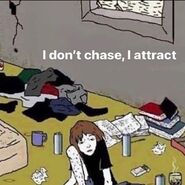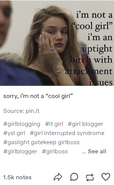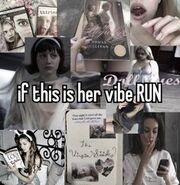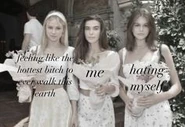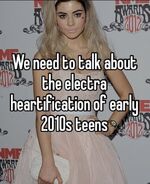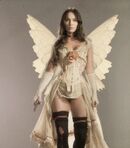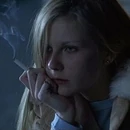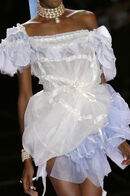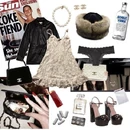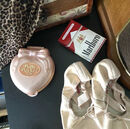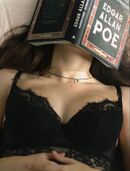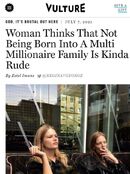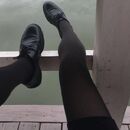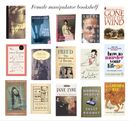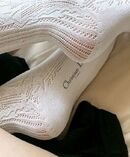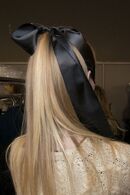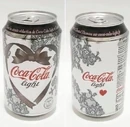Reason for Warning: This article discusses drugs, eating disorders, uncensored slurs, and mental illnesses.
Waif, also known as Girlblogger, Femcel, and Female Manipulator, is a type of Coquette blogger who posts content relating to rich, beautiful, intelligent, self-destructive, and manipulative teenage girls, wherein the imagery reflects the lifestyle that such a young woman would have. Largely, "nepotism girls" (female celebrities who got to their fame via nepotism), models, ballet dancers, and boarding school students are examples of these types of characters.
Arguably, it can be seen as a continuation of Heroin Chic, and it was influenced by Dark Nymphet, the Tumblr Sad Girl, and the Pro-Ana/thinspo community, literature with unlikeable protagonists, and the humor of the podcast The Red Scare. In addition to aesthetic images, much of this information comes from memes, Whisper confessions, and text posts of things happening within their personal lives.
What distinguishes this aesthetic from the previous aesthetics above is the persona of these bloggers. Rather than portraying themselves as delicate and broken, they put on a confidence and rudeness that shows independence and openness. Specifically, the memes and text posts produced have a flippant or egocentric tone. However, these girls are using it as an expression of their mental illness, and often it is implied that the narcissism is a show to hide deep insecurity. In addition to the glamour of independent and precocious lives of parties, money, and influence, there are multiple references to drug use, depression, daddy issues, eating disorders, and the desire to gain male attention from their looks. This is a continuation of many internet aesthetics' romanticization of toxic and unhealthy behaviors and personality traits, however many within the community genuinely suffer from these things and use these kinds of posts as a way to cope.
Other aesthetics with similar visuals but less controversial values include Dark Coquette, Dollette, and Coquette in general.
History[]
The visual motifs and philosophy in this aesthetic are largely a result of individual trends from 2020 that when combined, form the Waif aesthetic. To be specific, being skinny is becoming back in trend[1], balletcore and Coquette have their basis in runway fashion, and Catholicism is known to be edgy among Gen Z[2]. There is also a changing perspective on literature on social media where the identity of being a "reader" makes one attractive[3]. In addition, the rise of "girl internet,"[4] where young women identify with and label all of their habits as something related to "girls," is also extremely influential, with Waif being both a result and a propellent of the trend.
This aesthetic first appeared circa 2020 on Pinterest, Tumblr, and the Whisper app. It later spread onto Instagram, which largely reposts content from the latter two social media sites.
On Tumblr, these photos are proliferated through mass-tagging, some of which include the names of authors considered part of this community's canon and their books, ballet, Lana del Rey, Lizzie Grant (Lana's stage name), Lilly Rose Depp, Heroin Chic, etc.
Philosophy[]
Note: Because of the claims may be interpreted as harsh, there is a gallery with image evidence supporting the claims made here. The evidence is image-based because of the format being largely Whisper.
This aesthetic community largely preoccupies itself with femininity, specifically in the experiences, joys, and tragedies of being a feminine teenager, likely white and middle to upper-middle class. Texts often vent about the difficulties of teenagehood, with the accompanying expectations, insecurities, and uncertainties in the personality traits, romantic life, sexuality, academic/professional habits, etc. that a girl should inhabit. Despite this, many posts also celebrate the joys of girlhood, such as the fun that accompanies fashion, comraderie with other women, etc.
Appearance is one of the most primary discussions in this aesthetic; the girls who participate in this aesthetic have a preoccupation with becoming beautiful through becoming skinnier, having attractive clothing, and projecting an attitude resembling a desirable and confident person. One reason for this is that they recognize the social rewards for being so. The aesthetic's alternate name, "female manipulator," proves this, and through being determined to lose weight, multiple benefits such as modeling contracts (and thus, money)[5], being let into parties, being given free things by admirers, etc. could happen. Meanwhile, other posts say that this is purely on a self-esteem level, and their sense of confidence and selfhood entirely depends on how beautiful they are.
However, other waifs can be misanthropic, with them believing that most people in general are beneath them or undesirable as friends or romantic partners. The personal issues referenced in niche memes also relates to lacking friends or boyfriends (the aesthetic is highly cishet.) Depression, personality disorders, and general toxicity would ward off traditional relationships with healthy individuals. This is why another term for this aesthetic is "femcel." Many memes and whispers reference being chronically online, hating conversation, etc. This makes them share traits with many male incels.
Interestingly, many waifs are not actually femcels, but rather do it because it is a phrase that shocks and provokes, creating an edge that contrasts the traditionally feminine aesthetic.[6] Also note that this aesthetic is not to be confused with other aesthetics that use the term femcel, such as Femcel Weeaboo, or people who simply self-identify as femcels, who would not look through and engage with the community through an aesthetic lens.
As previously mentioned, gaining wealth and admiration is a common goal amongst these young women, and multiple memes and manifestation videos show their desire to be more intelligent. Despite partying and doing drugs having a strong emphasis, literature and prep schools are romanticized as a way to cope with the stress of school and being a high-achiever. Like in Dark Academia, pretentiousness is celebrated, and works of media considered prestigious (Dostoevsky, Sylvia Plath, etc.) and philosophy (French existentialism especially) are used to relate to their experience and a conversation topic rather than drudgery that other teenagers may believe. Many posts involve snippets of philosophical thoughts super-imposed over images. Rumination over relations of the self to others, gaining desire for the will to live, and thoughts over concepts introduced by philosophers and auteurs are common, including concepts of the erotic grotesque, the myth of Sisyphus, etc.
This leads into the community's common association with mental illness and personality disorders. All of the works listed in the media section feature protagonists who have issues of neuroticism and mental disorders (psychopathy in American Psycho, psychosis and hyper-perfectionism in Black Swan, depression in The Bell Jar, etc.) and the bloggers often express these characters' relatability to themselves. Often, they would aspire to be like one of these characters, as despite their personality flaws and poor relationships, the characters live picturesque lives filled with monetary success, beautiful lifestyles, drama, and occasionally, hope for recovery. This makes them cross over with the "literally me" film bros in that the viewer connects their lack of satisfaction in life with a similar character going through a heightened version of their struggle.
Embracing and advertising negative and toxic traits in this community is part of a larger trend online, especially with TikTok[7] and Whisper, an anonymous secret-sharing app. Discussing flaws such as being narcissistic, dishonest, unstable, etc. is a demonstration of authenticity and contrasts more mainstream ideas of toxic positivity, mental wellness, and being normal.
This led to the community’s sympathy for women deemed insane and/or cruel. Two figures discussed in this community are Amy Dunne and Jodi Arias, who both killed their romantic partners, albeit Amy Dunne is a fictional character from Gone Girl by Gillian Flynn while Jodi Arias is a real criminal. The women in this community often claim that these women were justified in carrying out their crimes because of the slights they experienced in their lives. Waifs relate to the insanity these characters have.
The emphasis on intellectualism also connects to Waifs' fascination with the esoteric, specifically with Catholicism. People in this community often relate to female saints in that they both are considered strange and unable to fit in with the people not being in the group. Femcels' lack of human connection can combine with the intellectualism and inner turmoil that relates to saints' lack of normal connections with other people. These Waifs often claim to receive divine messages and conect it with "delusions" or being "delusional." Nuns and saints being ascetic also connects to this community's emphasis on anorexia, which is a mental illness that can be caused by the desire to be "pure," including separation from food.
The persona of a femcel girlblogger is also steeped in irony. The community acknowledges its chronically online and mentally ill demographic that clashes with the imagery of the successful models and actresses in its imagery. A large part of the aesthetic's appeal is the contrast between traditional feminine image of rich girls being happy with sadness and toxicity, which are typically considered "ugly."
The aesthetic also includes multiple self-awareness in memes and text posts, with direct references to the concepts of personae, the hyperreal, the male gaze, etc., which would be known because of the aforementioned interest in philosophy.
Visuals[]
The images featured in this aesthetic are often edited to be more washed out through using a pale gray filter.
Images of glamorous types of people are one of the most common photo subjects. These are women who carry across the energy of this aesthetic in that they are beautiful but have an unapproachable and cold aura about them. Thin, with either blasé or cheeky expressions, and unglamorous clothing are their common qualities. Supermodels, often Naomi Campbell, Devon Aoki, the Hadid sisters, Anya Taylor Joy, Kate Moss, and Lily Rose Depp in candid photos with unprofessional lighting and grimy environments are popular.
Fashion images are the next most popular subject. Runway details, designer storefronts, shopping bags, and cosmetics showcase the beauty of these girls and the aspirational lifestyle they have.
Another important visual is that of bedrooms, as an introverted teenaged girl would spend her time there most often. These bedroom photos have a range of looks. Some are messy and chaotic to the point of disfunction, which is modeled off of Dasha Nekrasova, the more popular host of The Red Scare podcast, who has a New York apartment with clothes on every surface and only a mattress in the center. Meanwhile some are sparse to the point of asceticism, with only white as the color. Often, this includes a single cross on the wall. Another bedroom archetype relates more towards the hyper-feminine, Dollette-leaning bloggers, with large amounts of pink girly objects such as candles, ornate bed frames, and fluffy pillows.
Ballet is another important visual, specifically those of ballet academies in Russia. Rather than images of performances with full costumes, however, these images always take place during class or independent practice. The colors associated with class uniforms and the setting: black, off-white, pale pink, and gray, fit the color palette. Images of "what's in my bag" for ballet students are also popular; pointe shoes, iPods, towels, magazines, etc. arranged haphazardly are common.
Building off from above, Russian culture is frequently referenced in fashion (fur hats), literary tastes, memes about ballet, and whispers expressing the desire to move to the nation. The stereotypical image of a Russian woman: conventionally attractive, thin, pale, blonde-haired, and blue-eyed and the fact that Dasha Nekrasova is from Belarus would contribute to this admiration.
There are frequent references to having cigarettes and black or iced coffee, which are substitutes for food that have connotations associated with sophistication. Likewise, canned Diet Coke is another common photo subject and a reference to anorexics. Schnapps and vodka, especially cherry-flavored, refer to the Lana del Rey song "This is What Makes Us Girls," Russia fixation, and party lifestyle that these girls strive for.
Catholic school imagery is also popular. Schoolgirls in uniform, nuns, Bibles, and rosaries often appear as visuals. In whispers and text posts, these young women regularly joke about their Catholic upbringing, such as the religious trauma they experienced and the inside jokes that comes with living through similar life experiences. Catholic motifs in fashion have become popular in late 2021-early 2022 alternative fashion, with irony and sincerity being blurred.[8] The contrast between the overt sexuality, drugs, and partying juxtapose the image of a devout Christian.
Similarly, prep school in general is often referenced. Images of Rory Gilmore and other fictional characters or celebrities in school uniforms reading and holding books of high literary merit are common. Literature is celebrated, with books by Sylvia Plath, Dostoevsky, and the Bronte sisters appearing in memes and bookshelf images.
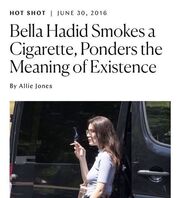
An example of an edit done to make it look like an article from The Cut, which uses this distinctive title font and quip-y subtitles.
Edited screenshots of news articles from the digital magazines Vulture and The Cut are common, where, instead of a fashion/cultural title, the magazine would "report" on the mundane activities of a "girlblogger" (a young woman who is chronically online), or a model.
There are also multiple variations on the aesthetic, with users leaving out certain elements or adding images with Preppy, Nymphet, Pink Parisian, and Shabby Chic aesthetics. The constant between all Waif bloggers is their admiration for models and the shared language and memes.
For the purposes of citation and examples, see the Wayback Machine archive of the Tumblr tag.
Online Culture[]
One of the main modes of conveying this aesthetic are Whispers, which are from an app of the same name. In them, users have to overlay a confession over an image. Waifs use imagery that matches the aesthetic, and text that communicates the typical thoughts relating to the characteristics of a waif. Word salads are fairly common, and describe the aesthetic in an overwhelming, chaotic way that mimics some prose of authors that these women read.
Slogans and a shared vocabulary are also incredibly repeated in this community. Some of them include:
- "Gaslight, gatekeep, girlboss"
- "Hot girls read."
- female manipulator
- the word "delusional," with the delusions not being specified
- I'm like (toxic male fictional character, songs, objects, etc.) but a girl
- God's favorite
- In my (word salad, fictional character, songs, etc.) era
- Using brunette and blonde as personality traits
- The feminine urge to...
- femcel, -pilled and trad, which originate from 4chan reactionary communities but later became popular with Gen Z teens
- "-ification" attached to another feminine word like "bimbofication"
- References to spirituality, such as manifesting, angel numbers, and zodiac signs
- "esoteric" as a way of describing themselves, typically in reference to spirituality, nicheness of film taste, etc.
- "This is what makes us girls," which is a reference to the Lana del Rey song with this phrase as the title. Many times, the comments would have the rest of the song line by line.
- [Blank] girl autumn/winter, a variation on the phrase "christian girl autumn", which itself is a variation on "hot girl summer"
- Phrases that address a "girl," such as girl help, girls when…., girlies, girlypop
- Rotting, referring to not doing anything active, and instead being in bed
- "It Girl," which is a term that describes women who have become incredibly popular and gained media attention for being remarkably beautiful, mysterious, and charismatic
- Describing themselves as "haters"
- If this is her (Pinterest, wardrobe, etc.).. RUN
- "Skinny" as a superlative adjective
- References to "The Joker," the Batman villain who, in the portrayal with Joaquin Phoenix, snaps and becomes a mass-murderer after a life of mental illness and social ostracization. This portrayal is also admired by toxic men on the internet
- References to Jodi Arias and Amy Dunne. See the Philosophy section for an explanation
- Slurs such as "r*tard" and "f*ggot" (The slurs are censored to navigate Fandom.com's terms of service)
Memes[]
Memes are an incredibly common way to link these aesthetic visuals together and create a community. One format that is incredibly popular is the "I would go to school if..." meme where "if this were the teacher" is captioned under an image of a model, "if this was the uniform" under the fashion with the aesthetic, "if this was the lunch" under Diet Coke and cigarettes, etc.
Another common meme is the "Are ya winning, daughter?" format edited with PNGs of the visuals, garments, albums, and books associated with the community surrounding a simple drawing of a crying or smiling girl and her father checking in on her.
Waifs also create crowded collages with overlayed text saying some variation of "if this is her vibe, RUN."
The "You are the average of the five people you spend the most time with. The five people in question:" template overlays the quote above and different outlines of five people with pngs of the above visuals.
Another meme is "boys' pockets versus girls' pockets," where under the boy's pockets are standard objects such as keys and a phone, while the girl has Waif-related objects.
Many Waif photos are also pictures of models with text over them that is meant to represent an experience the Waif has with her personality.
Another way waifs participate in the aesthetic is through comment/tag games where an image with different waif-related categories of media and visuals (books, albums, beverages, types of skirts, etc.) are in rows with numbers, letters, and symbols above each item. A user then puts the symbols of what they would pick from each category in the comments.
Many women also put an illustration of the insectoid protagonist Greogor Samsa in Franz Kafka's Metamorphosis as a representative of themselves in memes, representing the alienation he feels after transforming from a normal man into a pest.
Outfit moodboards and object collections link the different components of the aesthetic together. The outfit is often accompanied by transparents of coffee, newspaper headlines, cigarettes and other drugs, and books.
Fashion[]
This section is under construction
Tops[]
- Camisoles, often black or white with lace detailing
- Slip dresses
- Babydoll tops
- Milkmaid-style blouses
- Tank tops that have a grunge-y print
- Tight-fitting cardigans typically worn with camisoles underneath
Bottoms[]
- Extremely short pleated skirts, an article of clothing often associated with Y2K and Heroin Chic
- Plaid and check mini skirts, often from Burberry and with the distinctive belt piece detail
- Chiffon wrap skirts used in ballet practice clothing
- Low-waisted jeans
Shoes[]
- UGG boots
- Leather patent heels
- Ballet flats
Outerwear[]
- Fur coats. This item of clothing is an important narrative device in My Year of Rest and Relaxation and is associated with wealthy women
Accessories[]
- Crucifix necklaces
- Visible underwear such as whale tail thongs (Red Scare sells some as merch) and bralettes
- Sheer tights, mostly from Gucci with the lace interlocking Gs
- Stockings
- Gold jewelry with pearls
- Leg-warmers, influenced by ballet practice clothing
- Socks worn with heels
- Tote bags
- Vintage purses
- Fur hats
Media[]
The media that is considered "Waif" comes from the various edits, whispers, text posts, and images that these young women post. As such, what is considered part of the Waif "canon" comes from the frequency of these works being mentioned.
As previously discussed, the commonality between these works is the motif of mental illness or disordered personalities. Because of this, most of the works here are in the psychological drama genre.
Aesthetically, these works may or may not resemble Waif visually. For example, there are many references to the Joker, a comic book villain, in memes, but the movies he is in clashes with the aesthetic. On the other hand, many works also become more known for the aesthetic than for the motifs. Marie Antoinette, for example, is more light-hearted than the other movies featured but the hyper-feminine visuals make Waifs put it in the backgrounds of Whsipers.
Movies[]
- Valley of the Dolls (1967)
- Buffalo '66 (1998)
- The Virgin Suicides (1999)
- Girl, Interrupted (1999)
- American Psycho (2000)
- Thirteen (2003)
- Mean Girls (2004)
- Sympathy for Lady Vengeance (2005)
- Jennifer’s Body (2009)
- Black Swan (2010)
- Gone Girl (2014)
- The World of Kanako (2014)
- The Handmaiden (2016)
- Joker (2019)
- Pearl (2022)
TV Shows[]
- Gilmore Girls (2000)
- Skins UK (2007)
- Gossip Girl (2007)
- Pretty Little Liars (2010)
- Breaking Bad (2008)
- Better Call Saul (2015)
- Girl From Nowhere (2018)
- Mr. Robot (2015)
- Euphoria (2019)
- Taxi Driver (2021)
Books[]
- The Bell Jar by Sylvia Plath
- The Chic Diet by Kit Olsen
- Gone Girl by Gillian Flynn
- Lolita by Vladimir Nabokov
- My Year of Rest and Relaxation by Ottessa Moshfegh
- The Secret History by Donna Tartt
- How to Murder Your Life by Cat Marnell
- French Women Don't Get Fat by Mireille Guiliano
- Wasted by Marya Hornbacher
- Metamorphosis by Franz Kafka
Podcasts[]
- Red Scare (2018)
Music[]
The music associated with the aesthetic originates mostly from Pale Grunge 2014 Tumblr.
Artists[]
- Arctic Monkeys
- Lana Del Rey
- Amy Winehouse
- MARINA
- Fiona Apple
- Mitski
- Hole
- Nicole Dollanganger
- The Smiths
- Mazzy Star
Activities[]
One of the most commonly referenced things in Whispers is being in a bedroom, either relaxing with Lana del Rey music and social media, or having poor mental health. This is often called "rotting."
As previously discussed, reading literature and philosophy and watching films are a large component of the aesthetic.
In contrast, the images on these blogs often show smoking, drugs, and reference parties in songs, implying that this sort of lifestyle is desired. Note that this is all said online, meaning that a lot of these party and drug references are not necessarily true, and these young women could be making confessions for the sake of gaining popularity and exploring fantasy, rather than actually living out the lifestyle of a "waifspo" character.
New Age spirituality/teen girl pseudoscience is popular in this community, specifically with "manifesting", where people focus their thoughts to bring money, beauty, success, etc. into reality. This can also be brought on by listening to "subliminals", which are videos of montages set to music that would supposedly implant subliminal messages into the brain and bring about whatever the video's purpose is. Some common subliminal video topics include becoming skinnier, richer, and having an enhanced confidence.
Criticism[]

"toxic" femininity- what's up with girlbloggers, female manipulators, and femcels?
A video critiquing the waif/femcel community
Of course, the largest and most obvious criticism of Waif is the encouragement of eating disorders. In creating a clique where a BMI below the healthy amount is encouraged and starving oneself is celebrated, young women may begin to develop anorexic behaviors in order to fit into the in-group.
These images also trigger those who are currently in the process of overcoming eating disorders.[9] As the aesthetic becomes more popular online, people who are in danger of relapsing may do so because of the constant reminders of anorexia.
Many people, especially Tumblr veterans, simply find this community annoying. Because their posts are formulaic and use consistent visuals and meme formats, they quickly become repetitive. This is especially true when Waifs use an abundance of tags that are unrelated to the photo. For example, tagging Vladimir Nabokov in an image of supermodels.
In addition, fans of the music and films that are labelled as being in the Waif aesthetic dislike this community because these young women misinterpret these works to the detriment of the actual artist's intent and the perception of the fans of the artist. Many of the works the Waifs admire have the theme that these negative personality traits should be overcame, criticize society, or were born out of the creator's own grief and personal struggle. People emulating the characters means that they do not truly understand the work or use critical thought in reading/watching/listening.
The performative nature of the aesthetic, especially about negative traits such as narcissism and manipulativeness is also mocked. As the image below says, constantly claiming that one has these negative traits is "cringe" in that a person who is genuinely manipulative, intelligent, etc. would not want to or have to brag about it online.
Gallery[]
References[]
- ↑ https://www.theguardian.com/lifeandstyle/2022/nov/13/skinniness-is-back-in-fashion-but-did-it-ever-really-go-away
- ↑ https://i-d.vice.com/en_uk/article/g5b4d9/catholicism-alt-fashion-trend-think-piece
- ↑ https://www.gq-magazine.co.uk/culture/article/booktok-tiktok-books-community
- ↑ https://www.nytimes.com/2023/09/10/style/girls-internet-gender.html
- ↑ Image of an unattributed quote. "Sure, we had to be skinny...But I made a million dollars by the time I was 20...Does that make me a victim?"http://web.archive.org/web/20211203035119/https://morgueheart.tumblr.com/post/660609471798706176
- ↑ https://www.theatlantic.com/technology/archive/2022/05/femcel-meaning-female-incel-reddit/629836/
- ↑ https://i-d.vice.com/en_uk/article/z3nxz4/tiktok-toxic-traits
- ↑ https://i-d.vice.com/en_uk/article/g5b4d9/catholicism-alt-fashion-trend-think-piece
- ↑ https://www.reddit.com/r/EDAnonymous/comments/qrxw3m/the_waif_aesthetic_is_triggering/

